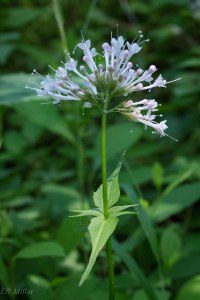There are a lot of pink wildflowers in the Maryland Piedmont. As with blue and purple, “pink” can vary quite a bit, from almost white to practically red.
 Claytonia virginica (spring beauty; Portulacaeae)
Claytonia virginica (spring beauty; Portulacaeae)
One of our earliest ephemerals, blooming as early as late February after a warm winter, and lasting into May. In woodland soils almost everywhere. Usually white with a pink tint.
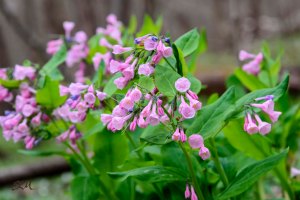 Mertensia virginica (Virginia bluebells; Boraginaceae)
Mertensia virginica (Virginia bluebells; Boraginaceae)
Virginia bluebell buds start violet and turn pink before opening blue, except when the flowers are pure white or pure pink. I visit this stand every year just to make sure that the flowers really are all pink from start of bloom through senescence. They are.
 Cercis canadensis (redbud; Fabaceae)
Cercis canadensis (redbud; Fabaceae)
Around here, this understory tree usually blooms in April, when other trees are just starting to blush green. It’s a beautiful effect, though maybe not as stunning as…

Rhododendron periclymenoides (pinxter azalea; Ericaceae)
I don’t know that we have a more stunning native shrub than this. I’ve seen it in rocky, wet areas in Rachel Carson Conservation Park and Sugarloaf Mountain; it blooms in mid spring.
 Silene caroliniana ssp. pensylvanica (wild pink; Caryophyllaceae)
Silene caroliniana ssp. pensylvanica (wild pink; Caryophyllaceae)
Look for the flowers in early April to late May. These low-growing plants are often found in dry, rocky soils in open woodlands. There are several stands near Carderock.

Valeriana pauciflora (long-tube valerian, large-flower valerian; Valerianceae)
This delicate plant (S1/endangered) has an explosive inflorescence that usually opens in May. A great photo has always eluded me, despite hours and hours and hours of trying, because the plants bloom in the deep shade of dense woods. Shade is the bane of photographers. Maybe this year.
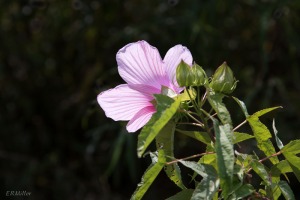 Hibiscus laevis (halberd-leaved rosemallow; Malvaceae)
Hibiscus laevis (halberd-leaved rosemallow; Malvaceae)
Unlike the previous species, this one likes bright, sunny riverbanks. I love how it just glows in the light! Sometimes considered a forb and sometimes as a shrub, it’s a very tall plant with stems that get somewhat woody as the season progresses; but, like a forb, it dies back to the crown in autumn. Watch for it in early to mid summer. S3 in Maryland.
 Hylodesmum nudiflorum (naked-flower tick trefoil; Fabaceae)
Hylodesmum nudiflorum (naked-flower tick trefoil; Fabaceae)
The tick trefoils can be tricky to identify, but this one stands out because the flowers are borne on leafless stems. The genus Desmodium was recently split, with some species placed in a new genus, Hylodesmum. According to the excellent gobotany site, species in the former as sun-loving, and species in the latter are shade-loving.
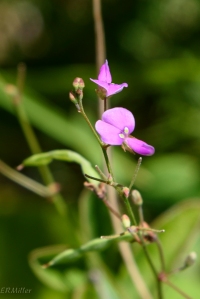 Desmodium paniculatum (panicled tick-trefoil; Fabaceae)
Desmodium paniculatum (panicled tick-trefoil; Fabaceae)
This one blooms in mid to late summer. It grows in moist to dry soils in sun to part shade, and does well in disturbed areas.
 Lespedeza virginica (Fabaceae) Not seen as often as the alien invasive L. sericea, this species grows in dry areas, blooming in mid to late summer.
Lespedeza virginica (Fabaceae) Not seen as often as the alien invasive L. sericea, this species grows in dry areas, blooming in mid to late summer.
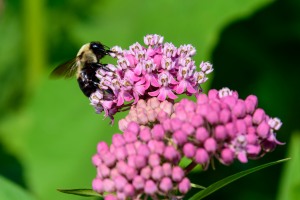 Asclepias incarnata (swamp milkweed; Apocynaceae)
Asclepias incarnata (swamp milkweed; Apocynaceae)
If you want to spend hours being entertained by bees and butterflies, park yourself in front of a stand of milkweeds. I’ve seen them blooming in wet soils in sunny areas from late June to late August.
 Persicaria amphibia (water smartweed; Polygonaceae)
Persicaria amphibia (water smartweed; Polygonaceae)
Or, as I prefer to call it, DPP (damn pink persicaria). I’m fairly certain I’ve ID’d it correctly. Sometimes I’m not particularly attracted to a species until I sit and study it awhile and try to get good close-up pictures. So it was with this one. Click on the pic to see it larger. It’s pretty up close!
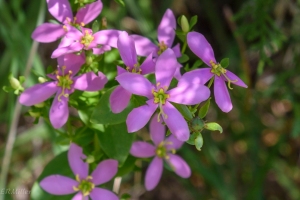 Sabatia angularis (rosepink; Gentianaceae)
Sabatia angularis (rosepink; Gentianaceae)
I’ve only seen this plant once, in the shade of a small shrub even though it’s a sun-loving species. Watch for it in dry soils in open places. What a beautiful color.
 Two weeks ago I mentioned long-tube valerian in a post. This plant bedevils me. It grows in the deep, deep shade of the woods, often along the banks of seasonal streams and in other very moist soils. The deep shade makes it difficult to photograph, especially since I need to use a very small aperture to get the entire inflorescence in focus.
Two weeks ago I mentioned long-tube valerian in a post. This plant bedevils me. It grows in the deep, deep shade of the woods, often along the banks of seasonal streams and in other very moist soils. The deep shade makes it difficult to photograph, especially since I need to use a very small aperture to get the entire inflorescence in focus. Valeriana pauciflora, whose other common names are few-flowered valerian and large-flowered valerian, is in the Caprifoliaceae (honeysuckle family), and is listed S1/endangered by the Maryland DNR. Its native range is restricted almost entirely to the Ohio River drainage basin, along with a few occurrences on the lower Susquehanna River, central Maryland, and northern Virginia.
Valeriana pauciflora, whose other common names are few-flowered valerian and large-flowered valerian, is in the Caprifoliaceae (honeysuckle family), and is listed S1/endangered by the Maryland DNR. Its native range is restricted almost entirely to the Ohio River drainage basin, along with a few occurrences on the lower Susquehanna River, central Maryland, and northern Virginia.
























